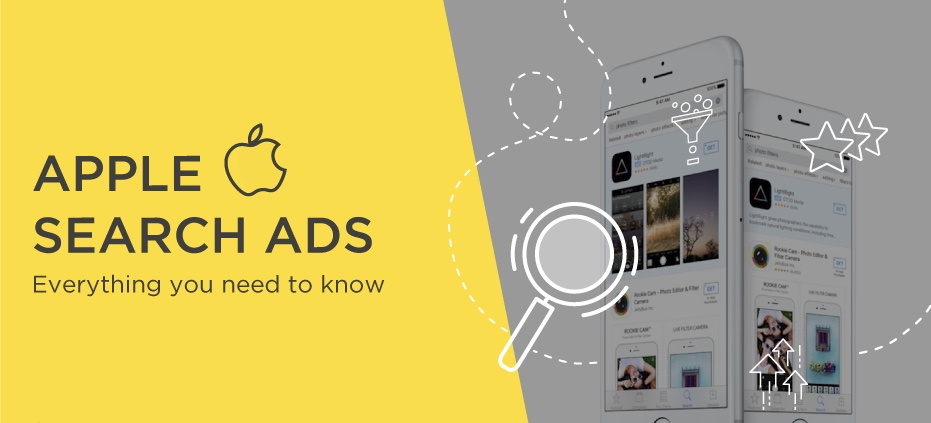Apple Search Ads: An Insider’s Introduction

Should you own an iOS application that’s registered in the App Store, to guarantee visibility to your target audience, Apple Search Ads becomes a necessity. This platform lets you establish and operate paid advertisements based on prime search inquiries, which help drive actual users towards your application. To ensure the investments and advertisements prove fruitful, gaining an in-depth understanding about the many features and makeup of the Search Ads system is advised.
Native advertising instead of intrusive
Ads appearing in app store search results are identical to organic search results. They are smoothly incorporated into the marketplace interface, minimizing user irritation.
Advertisements in app store search displays resemble their organic counterparts. These ads are subtly embedded into the store’s interface, ensuring users’ browsing experience remains uninterrupted and frustration-free.
The sponsored content within an app store’s search results mirrors the look and feel of regular, non-sponsored search results. Such ads are cleverly integrated into the marketplace layout, avoiding any potential annoyance for users.
In the app store, sponsored search findings don’t differ in appearance from regular ones. The ads are artfully mixed in with the standard interface of the marketplace, so as not to provoke an adverse reaction from users.
On the app store, sponsored search results blend in with regular results, ensuring a harmonious visual flow. These commercials are expertly woven into the marketplace’s user interface, mitigating any potential user disappointment.

Relevance comes first
Apple’s Search Ads, along with similar marketing platforms, organize bidding competitions to decide the placement of an ad within a given search. However, there’s a significant catch here – when the bids are either identical or closely matched, precedence is awarded to the more contextually apt proposition.
The App Store presents itself as a guide in uncovering the most suitable applications for its users. As such, the system meticulously scrutinizes every proposed app, assessing its potential in addressing the user’s needs, appended metadata, the array of screenshots, and accompanying designated search terms. With Search Ads, it’s forbidden to use a rival’s app name to market your own application. Another key point to consider is the importance of preparedness in the advertising arena. A sponsored promotion for a useful app, paired with thoughtfully curated keywords, promises to yield high conversion rates and a stream of quality-driven, targeted traffic.

Consumer Confidence
One of the key perks of promoting your business on the App Store is the high level of trust and assurance it offers to your target audience. Firstly, the assurance that they will not be redirected to a third-party platform when they click on an ad instills a sense of security in the users. Moreover, considering the App Store’s exceptional strategy in ad placements, the users can rest assured that they will land on an application page that accurately matches their needs and search intent.
Are there downsides?
While some features of Search Ads may appear uncommon or even burdensome compared to similar systems on Google Ads and Facebook Ads, such minor differences are well within the expertise of a seasoned marketing professional. Let’s delve into these distinctive traits further:
- Search Ads alone may not be as productive as when coupled with other platforms in enhancing promotion. Experts discourage confining your marketing efforts to the App Store, advising instead to tap into additional promotional venues.
- In comparison to advertising on Facebook and Google, there are significantly fewer creative elements on this platform. Apple Search Ads operates solely using the graphic material provided by the marketer’s app. Hence, it’s essential to have all aspects meticulously prepared prior to advertising. That being said, if you deploy an advanced advertising account, you have the freedom to include your optional screenshots.
- Achieving a 100% reach to your target audience is not guaranteed, which is chiefly due to Apple’s staunch commitment to user privacy. Given that approximately half of user personal data remains concealed, this information remains inaccessible for ad configuration. Consequently, the view of the target audience may appear somewhat nebulous.
- There can be discrepancies in statistical data when compared to third-party trackers. While Search Ads accounts for every app download, several third-party trackers also consider any subsequent use or a minimum of one visit. This divergence must be remembered when analyzing and computing ROI.

Taking into account both the merits and demerits of Search Ads, it’s clear that this platform is a useful tool if you are developing applications for iOS. Key components for successful promotion incorporate the quality and utility of the applications, the audience’s intrigue with its features, and the appointment of a professional to manage and regulate the advertisements.
Contact Me


